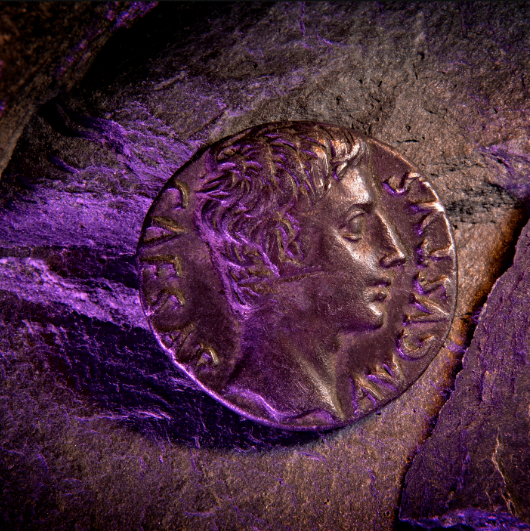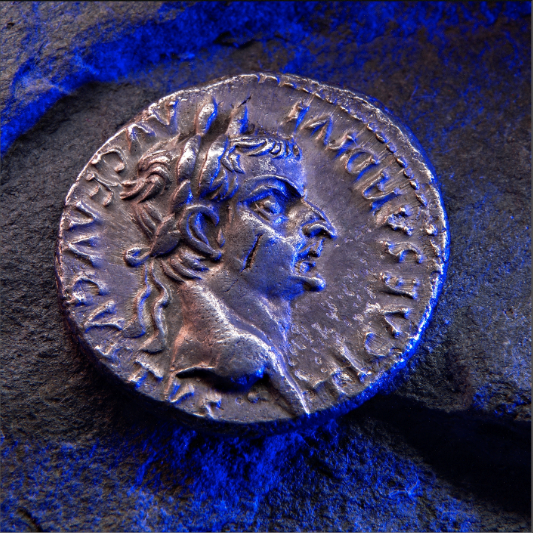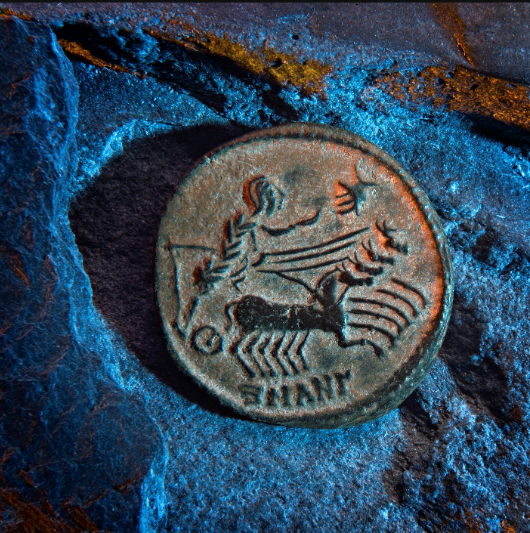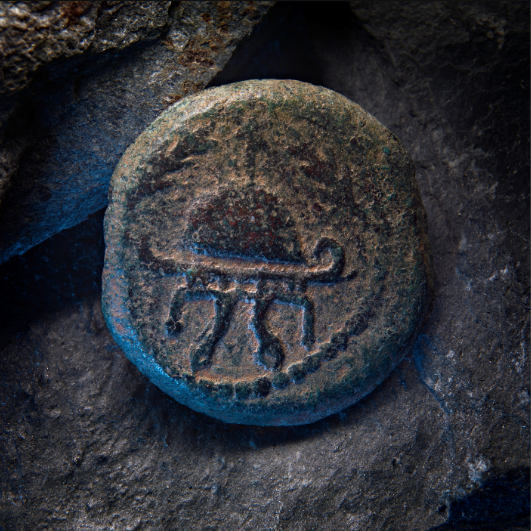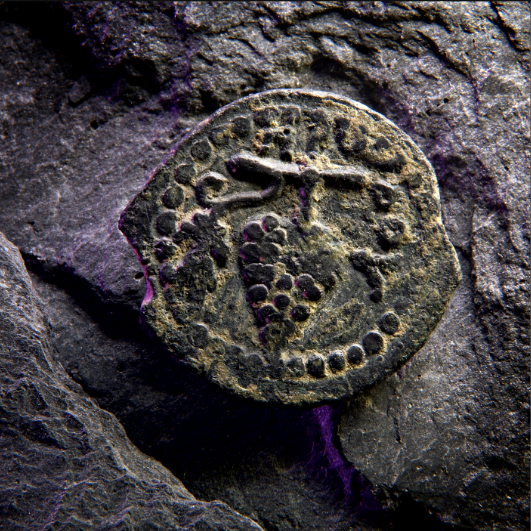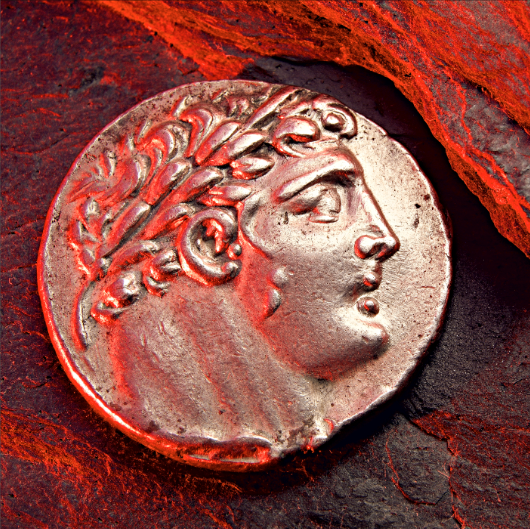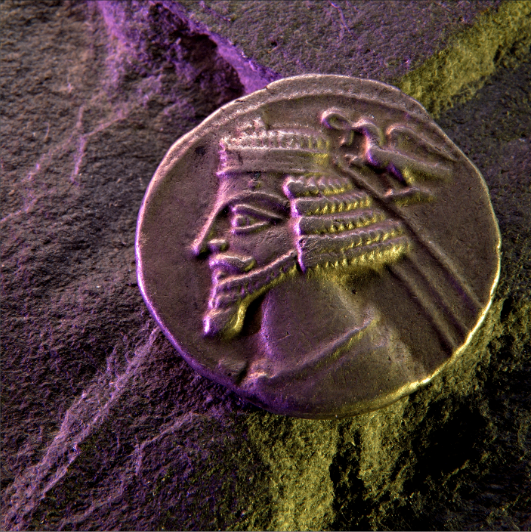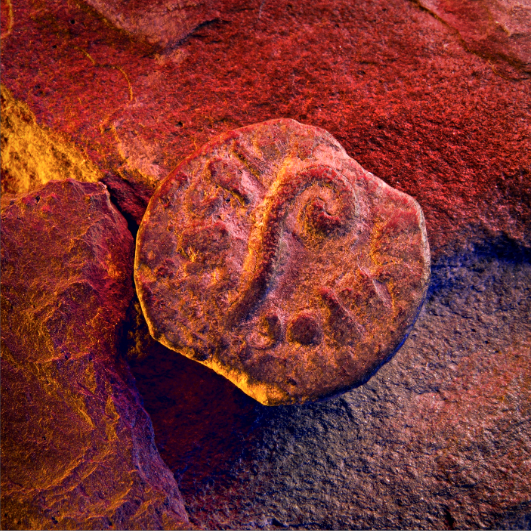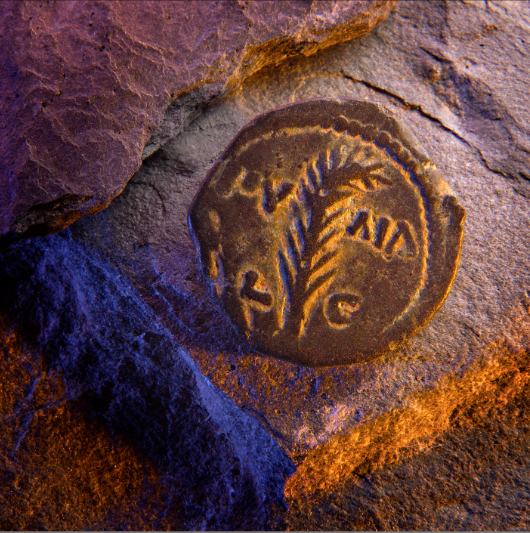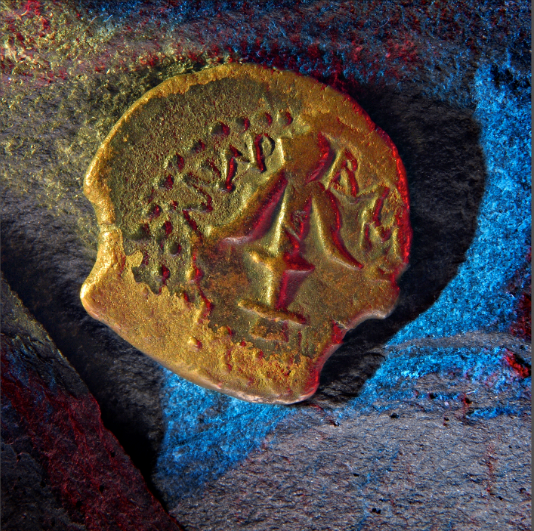Up Close: Coins of the Bible
Travelers on our Israel tours are often surprised to encounter archaeological digs taking place right before their eyes. They expect a spiritually profound experience, but are astonished when they also witness history being uncovered. From from the streets of Jerusalem to Judean caves near the Dead Sea, we introduce Believers to working excavations that are producing, daily, historical finds that authenticate the biblical narrative.
Most antiquities can only be found in museums, but a pastor near the Inspiration headquarters in California has acquired a number of biblical antiquities during a long missionary career in Europe. We were stunned by the exquisite detail this photographic exhibit captures. These coins are the type of artifacts we introduce travelers to on every one of our trips to the Holy Land. Enjoy!
Caesar Augustus
- 27 BC - AD 14
- Coin type: Denarius (Silver)
- Obverse: CAESAR AVGVSTVS around bare head of Augustus facing right
- Reverse: Circular shield inscribed S•P•Q•R / CL•V in 2 lines (= Senatus Populusque Romanus = The Senate & The People of Rome; 19/18 BC)
SIGNIFICANCE: The decree issued by Caesar Augustus set in motion the series of providential events that led Joseph and Mary to Bethlehem, where Jesus was born, for a tax census. The first emperor of the Roman Empire, Augustus gained control in 27 BC after defeating Mark Antony and Cleopatra.
In those days Caesar Augustus issued a decree that a census should be taken of the entire Roman world...and everyone went to their own town to register. So Joseph also went up from the town of Nazareth in Galilee to Judea, to Bethlehem the town of David, because he belonged to the house and line of David. He went there to register with Mary, who was pledged to be married to him and was expecting a child. While they were there, the time came for the baby to be born, and she gave birth to her firstborn, a son. She wrapped him in cloths and placed him in a manger, because there was no room for them in the inn. —Luke 2:1,3-7
Caesar Tiberius
- AD 14-37
- Coin type: Denarius (Silver)
- Obverse: TI CAESAR DIVI AVG F AVGVSTVS around diademed bust of Tiberius facing right
- Reverse: PONTIF MAXIM (= High Priest); Livia sitting, holding a scepter & an olive branch
SIGNIFICANCE: A former general, Tiberius ruled the Roman Empire for more than two decades, a span that covered the adult ministry, Crucifixion and Resurrection of Christ. He is mentioned by name in Luke 3:1, related to the ministry of John the Baptist. Many scholars believe the silver denarius presented to Jesus in the Gospels of Matthew and Mark was a coin like this one, which features Tiberius.
“Tell us then, what is your opinion? Is it right to pay the imperial tax to Caesar or not?” But Jesus, knowing their evil intent, said, “You hypocrites, why are you trying to trap me? Show me the coin used for paying the tax.” They brought him a denarius, and he asked them, “Whose image is this? And whose inscription?” “Caesar’s,” they replied. Then he said to them, "So give back to Caesar what is Caesar's, and to God what is God's." —Matthew 22:17-21
Constantine the Great
- AD 307-337
- Coin type: Æ 4 (Bronze)
- Obverse: DV CONSTANTINVS PT AVGG around the Emperor's veiled head facing right
- Reverse: Constantine in a 4-horse chariot galloping right; Constantine is reaching for the Hand of God above; the letters SMANT appear at the bottom (SM = Sacra Moneta [Holy Coin]; ANT = from the mint of Antioch)
SIGNIFICANCE: Known for his public conversion to Christianity, Emperor Constantine ended the Roman persecution of Christians in the 4th century. Following his death, Constantine’s sons minted coins depicting him being taken to heaven in a chariot pulled by four horses, while the “Hand of God” (visible in the upper right) reached for him. Notably, this 4th century bronze coin represents the first known Christian depiction of God on a Roman coin.
Coponius & Marcus Ambibulus
- AD 6-9 & AD 9-12
- Coin type: Æ Prutah (Bronze)
- Obverse: Ear of barley curved to right; KAICAPOC (= of Caesar)
- Reverse: Eight-branched palm tree bearing two bunches of dates; date in field LMA (= year 41 of Augustus = AD 11/12)
SIGNIFICANCE: These two bronze coins date back to the time when Jesus would likely have been a teenager. After the Roman province of Syria annexed Judea, Roman governors—also known as “prefects”—oversaw this territory from Caesarea and minted their own coinage. These are commonly known as Roman Procurator coins. The first such prefect was a man named Coponius. His three-year term was followed by Marcus Ambibulus. Both men issued coins displaying an ear of barley on one side and a palm tree on the other. The best-known Roman prefect was Pontius Pilate.
Herod Antipas
- 4 BC - AD 40
- Coin type: Æ 8 Prutah (Bronze)
- Minted just before Christ's crucifixion & resurrection
- Obverse: HPΩΔΟY TETPAPXOY (= Herod Tetrarch) around palm branch upright with date LAΓ (= year 33 or AD 29/30) in the right field
- Reverse: Rev: TIBE / PIAC (= Tiberius) inscription surrounded by a wreath
SIGNIFICANCE: Referred to as “Herod” or “King Herod” in the Bible, Herod Antipas was the 1st-century ruler of Galilee and Perea, which were client-states of the Roman Empire. He established the city of Tiberias, ordered the execution of John the Baptist (Matthew 14:1-12), and was involved in the arrest of Jesus—according to Luke, Pontius Pilate initially sent Jesus to Herod Antipas for trial before Antipas returned him to Pilate’s court. In Luke 13:32, when told that Herod wanted to kill him, Jesus referred to the ruler as “that fox.”
When he learned that Jesus was under Herod’s jurisdiction, he sent him to Herod, who was also in Jerusalem at that time. When Herod saw Jesus, he was greatly pleased, because for a long time he had been wanting to see him. From what he had heard about him, he hoped to see him perform a sign of some sort. He plied him with many questions, but Jesus gave him no answer. The chief priests and the teachers of the law were standing there, vehemently accusing him. Then Herod and his soldiers ridiculed and mocked him. Dressing him in an elegant robe, they sent him back to Pilate. That day Herod and Pilate became friends—before this they had been enemies. —Luke 23:7-12
Herod the Great "King of the Jews"
- 37-4 BC
- Coin type: Æ 8 Prutot (Bronze)
- Obverse: HPΩΔΟY BAΣIΛΕΩΣ (= King Herod) around a tripod with a ceremonial bowl on top; the date LΓ (= 37 BC) is left of the tripod
- Reverse: Military helmet surmounted by a star and flanked by two palm branches
SIGNIFICANCE: The father of Herod Antipas, Herod the Great was the client king of Judea, appointed by the Roman Senate in 40 BC. He was considered a tyrant and loathed by the Jewish people. Historically he is known for his building projects, which included expanding the Second Temple in Jerusalem, constructing the fortress at Masada and building the great seaport at Caesarea. Most notably, Herod was the ruler of Judea during the birth of Christ. According to Matthew, he met with the Wise Men, then ordered the execution of male infants because he feared the birth of the long-awaited King of the Jews.
When they had gone, an angel of the Lord appeared to Joseph in a dream. “Get up,” he said, “take the child and his mother and escape to Egypt. Stay there until I tell you, for Herod is going to search for the child to kill him.” So he got up, took the child and his mother during the night and left for Egypt, where he stayed until the death of Herod... —Matthew 2:13-15
Herod Archelaus
- 4 BC - AD 6
- Coin type: Æ Prutah (Bronze)
- Obverse: Bunch of grapes on a branch with one leaf; HPΩΔΟY (= Herod) above
- Reverse: Tall helmet with crest and cheek straps; caduceus in lower left field; Greek inscription EΘNAPXOY (= Ethnarch) at the bottom
SIGNIFICANCE: Archelaus was the brother of Herod Antipas and the son of Herod the Great. His rule began in 4 BC after his father’s death, at which point he inherited the southern territory that included the cities of Caesarea and Jaffa. Archelaus was opposed by his brother as well as the Jewish people, who viewed him as a cruel murderer. He is mentioned in Matthew 2 as part of the reason Jesus grew up in Nazareth. Some scholars also think Jesus’ parable about the ruling nobleman in Luke 19 may be a reference to Herod Archelaus.
After Herod died, an angel of the Lord appeared in a dream to Joseph in Egypt and said, “Get up, take the child and his mother and go to the land of Israel, for those who were trying to take the child’s life are dead.” So he got up, took the child and his mother and went to the land of Israel. But when he heard that Archelaus was reigning in Judea in place of his father Herod, he was afraid to go there. Having been warned in a dream, he withdrew to the district of Galilee, and he went and lived in a town called Nazareth. So was fulfilled what was said through the prophets, that he would be called a Nazarene. —Matthew 2:19-23
Judas Iscariot Betrayal Payment
- 126 BC - 1st Century AD
- Coin type: Tetradrachm (Silver)
- Obverse: Laureate head on Baal Melqart with lion's skin knotted around neck
- Reverse: Eagle standing left on rostrum of ship, carrying a palm branch under his right wing; Greek inscription reads "Year 32 of the Autonomy of Tyre;" the club symbol in the left field is the ancient monogram/mint-mark for the city of Tyre
SIGNIFICANCE: The silver equivalent of four drachmae, a tetradrachm was a common Greek coin in circulation during the time of Judas Iscariot’s betrayal of Jesus. Also known as a Tyrian shekel, this coin was worth around four days’ wages for a common laborer. These were often used to pay the Temple tax in Jerusalem, and may have been the type of coin Peter found in the mouth of a fish according to the account in Matthew 17. In present-day value, 30 pieces of silver would be the equivalent of around $200.
Then one of the Twelve—the one called Judas Iscariot—went to the chief priests and asked, “What are you willing to give me if I deliver him over to you?” So they counted out for him thirty pieces of silver. From then on Judas watched for an opportunity to hand him over. —Matthew 26:14-16
After Jesus and his disciples arrived in Capernaum, the collectors of the two-drachma temple tax came to Peter and asked, “Doesn’t your teacher pay the temple tax?”
“Yes, he does,” he replied.
When Peter came into the house, Jesus was the first to speak. “What do you think, Simon?” he asked. “From whom do the kings of the earth collect duty and taxes—from their own children or from others?”
“From others,” Peter answered.
“Then the children are exempt,” Jesus said to him. “But so that we may not cause offense, go to the lake and throw out your line. Take the first fish you catch; open its mouth and you will find a four-drachma coin. Take it and give it to them for my tax and yours.” —Matthew 17:24-27
Phraates IV Ruler of the Parthian Empire
- c. 38 - 2 BC
- Coin type: Drachm (Silver)
- Obverse: Diademed bust of Phraates IV facing left with pointed (regal) beard; eagle with wreath in beak behind rulers head
- Reverse: Archer enthroned (facing right), holding a bow; Greek legend forming a frame around the archer
SIGNIFICANCE: At the time of Christ’s birth, the enormous Parthian Empire—also known as the Arsacid Empire—occupied the territory east of Israel, which covers modern-day Iran and Iraq. It was ruled by Phraates IV until 2 BC. Many scholars speculate that the Wise Men, or “Magi from the east,” were subjects of Phraates IV, and may even have been his advisors.
After Jesus was born in Bethlehem in Judea, during the time of King Herod, Magi from the east came to Jerusalem and asked, “Where is the one who has been born king of the Jews? We saw his star when it rose and have come to worship him.” —Matthew 2:1-2
Pontius Pilate
- AD 26-36
- Coin type: Æ Prutah (Bronze)
- Issued the Year of the Crucifixion & Resurrection of Jesus Christ
- Obverse: Lituus surrounded by Tibepioy kaicapoc
- Reverse: Date within wreath LIZ (= Year 17 of Tiberius = AD 30)
SIGNIFICANCE: Like Coponius and Marcus Ambibulus, Pontius Pilate was a Roman prefect who minted his own bronze coinage. Pilate’s rule of Judea lasted from 26-36 AD, and history remembers him as the Roman ruler who found no charge against Jesus but still handed Him over to be crucified. This coin bears the date LIZ, which indicates it was minted during the 17th year under Emperor Tiberius. This would have been AD 30—the year most scholars believe Jesus died and rose to life. Pontius Pilate was the one who wrote, in three languages, the inscription above Jesus on the cross proclaiming Him the King of the Jews.
Therefore when Pilate heard this statement, he was even more afraid; and he entered into the Praetorium again and said to Jesus, “Where are You from?” But Jesus gave him no answer. So Pilate said to Him, “You do not speak to me? Do You not know that I have authority to release You, and I have authority to crucify You?” Jesus answered, “You would have no authority over Me, unless it had been given you from above… —John 19:8-11
Valerius Gratus
- AD 15-26
- Coin type: Æ Prutah (Bronze)
- Annius Rufus was prefect of Judaea from AD 12-15, but he minted no coins during this time. Valerius Gratus, his successor appointed by Caesar Tiberius, minted 6 different coin types during his rule from AD 15-26
- Obverse: TIB KAI CAP (Tiberius Caesar) in a wreath tied at the base with an X
- Reverse: Palm branch curving to the right flanked by IOY ΛΙΑ and the date LE (year 5 = AD 18)
SIGNIFICANCE: Valerius Gratus was the Roman prefect who preceded Pontius Pilate in the province of Judea. Like most other prefects, he minted bronze coins during his rule, including this one from AD 18. Valerius Gratus isn’t mentioned by name in the Bible, but history knows him as the ruler who made multiple appointments to the Jewish high priesthood. He replaced the high priest Annas ben Seth (Luke 3:2 and Acts 4:6) with a succession of priests that culminated in Josephus Caiaphas. Mentioned in John 18, Caiaphas was the acting high priest at the time of Jesus’ arrest.
...during the high-priesthood of Annas and Caiaphas, the word of God came to John son of Zechariah in the wilderness. He went into all the country around the Jordan, preaching a baptism of repentance for the forgiveness of sins. —Luke 3:2-3
Then the detachment of soldiers with its commander and the Jewish officials arrested Jesus. They bound him and brought him first to Annas, who was the father-in-law of Caiaphas, the high priest that year. —John 18:12-13
Alexander Jannaeus (Widow's Mites)
- 103-76 BC
- Coin type: Æ Prutah (Bronze)
- Obverse: The Greek Inscription ΒΑΣΙΛΕΩΣ ΑΛΕΞANΔΡΟΥ (= King Alexander) around anchor
- Reverse: Star with 8 rays inside dotted border; Aramaic inscription between rays
SIGNIFICANCE: The king of Judea from 103 to 76 BC, Alexander Jannaeus introduced bronze coins that were still in circulation during Jesus’ ministry. Known as lepton in Greek, these coins would have been the smallest available currency when Jesus told the famous parable of the Widow’s Mite. It would have required 384 coins like this one to equal a single silver denarius—or the equivalent of a single day’s wage.
But a poor widow came and put in two very small copper coins, worth only a few cents. Calling his disciples to him, Jesus said, “Truly I tell you, this poor widow has put more into the treasury than all the others. They all gave out of their wealth; but she, out of her poverty, put in everything—all she had to live on.” —Mark 12:42-44
These fascinating ancient coins with biblical connections are still being discovered on a daily basis in archaeological sites throughout Israel. They are just a small foretaste of the many antiquities awaiting discovery in the land of the Bible. Experience Scripture for yourself this year on one of our life-changing Israel tours!







